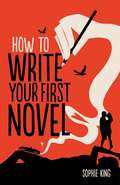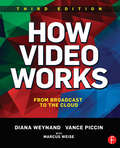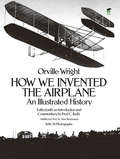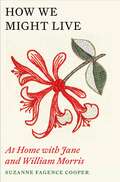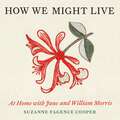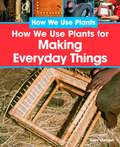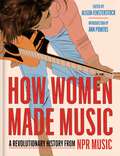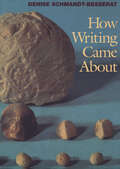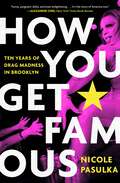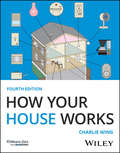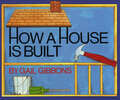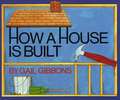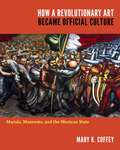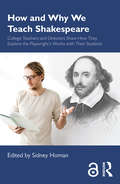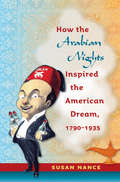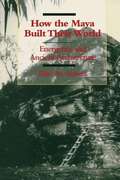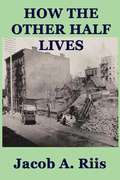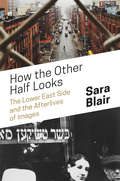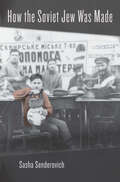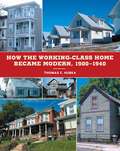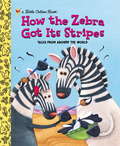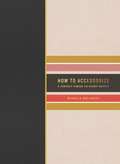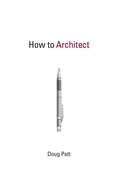- Table View
- List View
How To Write Your First Novel
by Sophie KingLet best-selling novelist Sophie King guide you through the whole process of writing your first novel and getting it published.This revised edition takes aspiring novelists through the steps of writing a novel, from finding that initial idea, to keeping the plot going and crafting the perfect ending. With helpful exercises in each chapter you will learn how to:- Develop a brilliant idea for your first novel - Create characters that will make your novel come alive - Plot your novel so that your readers simply have to turn the page - Unravel the mysteries of viewpoint - Create realistic dialogue and settings so your readers feel they are there - Find your own voice. - Most importantly, the book includes tips and advice on how to get published. This new edition also includes a ten step guide to revision so that you can polish your novel to be the best it can be.
How Video Works: From Broadcast to the Cloud
by Diana Weynand Vance PiccinHow Video Works raises the curtain on how video is created, scanned, transmitted, stored, compressed, encoded, delivered and streamed to its multitude of destinations. In today's digital world, every content creator--individual as well as network or corporation--must understand the process of how video works in order to deliver not only the best quality video, but a digital video file with the most appropriate specifications for each particular use. This complete guide covers key stages of video development, from image capture to the final stages of delivery and archiving, as well as workflows and new technologies, including Ultra High Definition, metadata, signal monitoring, streaming and managing video files - all presented in an easy to understand way. Whether you are a professional or new video technician discovering the ins and outs of digital distribution, this book has the information you need to succeed. The updated third edition contains: * New sections on image capture as well as streaming and video workflows * A hands-on approach to using digital scopes and monitoring the video signal * Thorough explanations of managing video files, including codecs and wrappers * In-depth coverage of compression, encoding, and metadata * A complete explanation of video and audio standards, including Ultra HD * An overview of video recording and storage formats * A complete glossary of terms for video, audio and broadcast
How We Invented the Airplane: An Illustrated History
by Orville WrightIt was the realization of a dream as old as mankind. On December 17, 1903, two bicycle mechanics from Dayton, Ohio, achieved the first sustained, powered, heavier-than-air flight in a machine of their own design and construction. This book offers a concise and fascinating history of that remarkable accomplishment, much of it in the words of the inventors themselves. The heart of the book is Orville Wright's personal account, written in connection with an obscure lawsuit filed against the U.S. government. Long forgotten until a typewritten copy was discovered among the Wright papers at the Library of Congress, it is the best, most detailed account of how the Wright brothers succeeded in creating the machine that lifted man into the sky on wings.The brothers first became interested in the problem of flight after reading about the glider experiments of Otto Lilienthal, a 19th-century German engineer. Experimenting first with kites and gliders, they developed a revolutionary wing design that helped solve the crucial problem of maintaining lateral equilibrium. Later, they added a movable rudder that eliminated the tendency of the machine to go into a tailspin. In addition to these critical innovations, the two inventors developed new accurate tables of "life" pressures and an original theory of air propellers. Slowly, methodically, with patience, perseverance, ingenuity, and inspired invention, they solved the problems that had defeated so many experimenters before them.Finally, on a gusty winter day in North Carolina, the Wright brothers flew their little motor-driven biplane off the sand at Kitty Hawk (actually Kill Devil Hills) and into the pages of history. Although the first flight lasted only about 12 seconds and covered barely 120 feet, it was the first time a machine carrying a man and driven by a motor had lifted itself from the ground in controlled free flight. A new era had begun and the world would never be the same again.The achievement of the Wright brothers is placed in historical context in the absorbing and informative introduction to this volume, written by Fred C. Kelly, author of two standard works on the Wrights. Mr. Kelly has also written an illuminating commentary, including fascinating anecdotes about the Wrights, their personalities and later aspects of their career. As an extra bonus, a lively popular account of the Wrights' success, written in 1908 by both brothers, has been included in an Appendix. Enhanced by 76 photographs, including many rare views of the Wrights and their flying machines, this book offers a thrilling reading experience for anyone interested in aviation, its pioneers, or the mechanics of flights.
How We Might Live: At Home with Jane and William Morris
by Suzanne Fagence CooperWilliam Morris - poet, designer, campaigner, hero of the Arts & Crafts movement - was a giant of the Victorian age, and his beautiful creations and provocative philosophies are still with us today: but his wife Jane is too often relegated to a footnote, an artist's model given no history or personality of her own. In truth, Jane and William's personal and creative partnership was the central collaboration of both their lives. The homes they made together - the Red House, Kelmscott Manor and their houses in London - were works of art in themselves, and the great labour of their lives was life itself: through their houses and the objects they filled them with, they explored how we all might live a life more focused on beauty and fulfilment.In How We Might Live, Suzanne Fagence Cooper explores the lives and legacies of Jane and William Morris, finally giving Jane's work the attention it deserves and taking us inside two lives of unparalleled creative artistry.
How We Might Live: At Home with Jane and William Morris
by Suzanne Fagence CooperWilliam Morris - poet, designer, campaigner, hero of the Arts & Crafts movement - was a giant of the Victorian age, and his beautiful creations and provocative philosophies are still with us today: but his wife Jane is too often relegated to a footnote, an artist's model given no history or personality of her own. In truth, Jane and William's personal and creative partnership was the central collaboration of both their lives. The homes they made together - the Red House, Kelmscott Manor and their houses in London - were works of art in themselves, and the great labour of their lives was life itself: through their houses and the objects they filled them with, they explored how we all might live a life more focused on beauty and fulfilment.In How We Might Live, Suzanne Fagence Cooper explores the lives and legacies of Jane and William Morris, finally giving Jane's work the attention it deserves and taking us inside two lives of unparalleled creative artistry.(P)2022 Quercus Editions Limited
How We Use Plants for Making Everyday Things
by Sally MorganMany of the things we use each day are made from plants. Readers may not realize that the clothes they wear or the rubber tires on their bicycle are made from plants. This book covers plant-based items from fabrics to paper. Students will have the opportunity to participate in the process as they learn how to make their own paper!
How Women Made Music: A Revolutionary History from NPR Music
by National Public Radio, Inc Alison FensterstockDrawn from NPR Music’s acclaimed, groundbreaking series Turning the Tables, the definitive book on the vital role of Women in Music—from Beyoncé to Odetta, Taylor Swift to Joan Baez, Joan Jett to Dolly Parton—featuring archival interviews, essays, photographs, and illustrations.Turning the Tables, launched in 2017, has revolutionized recognition of female artists, whether it be in best album lists or in the Rock and Roll Hall of FameHow Women Made Music: A Revolutionary History from NPR Music brings this impressive reshaping to the page and includes material from more than fifty years of NPR’s coverage plus newly commissioned work. A must-have for music fans, songwriters, feminist historians, and those interested in how artists think and work, including: • Joan Baez talking about nonviolence as a musical principle in 1971• Dolly Parton’s favorite song and the story behind it • Patti Smith describing art as her “jealous mistress” in 1974• Nina Simone, in 2001, explaining how she developed the edge in her voice as a tool against racism.• Taylor Swift talking about when she had no idea if her musical career might work• Odetta on how shifting from classical music to folk allowed her to express her fury over Jim Crow This incomparable hardcover volume is a vital record of history destined to become a classic and a great gift for any music fan or creative thinker.
How Writing Came About
by Denise Schmandt-BesseratIn 1992, the University of Texas Press published Before Writing, Volume I: From Counting to Cuneiform and Before Writing, Volume II: A Catalog of Near Eastern Tokens. In these two volumes, Denise Schmandt-Besserat set forth her groundbreaking theory that the cuneiform script invented in the Near East in the late fourth millennium B. C. -the world's oldest known system of writing-derived from an archaic counting device. How Writing Came About draws material from both volumes to present Schmandt-Besserat's theory for a wide public and classroom audience. Based on the analysis and interpretation of a selection of 8,000 tokens or counters from 116 sites in Iran, Iraq, the Levant, and Turkey, it documents the immediate precursor of the cuneiform script.
How You Get Famous: Ten Years of Drag Madness in Brooklyn
by Nicole PasulkaA madcap adventure through a tight-knit world of drag performers making art and mayhem in the greatest city on earth.Ten years ago, an aimless coat check girl better known today as Merrie Cherry sweet-talked her boss into giving her $100 to host a drag show at a Brooklyn dive bar. Soon, kids like Aja were kicking their way into the scene, sneaking into clubs, pocketing their tips to help mom pay the mortgage, and sharing the stage with electric performers like Thorgy Thor and Sasha Velour. Because suddenly, in the biggest, brightest city in America, drag was offering young, broke, creative queer people a chance at real money—and for thousands or even millions of people to learn their names. In How You Get Famous, journalist Nicole Pasulka joyfully documents the rebirth of the New York drag scene, following a group of iconoclastic performers with undeniable charisma, talent, and a hell of a lot to prove. The result is a sweeping portrait of the 21st-century search for celebrity and community, as well as a chronicle of all the struggles, fights, and disappointments along the way. A rollicking account of the quest to make a living through an art form on the cusp of becoming a cultural phenomenon, How You Get Famous offers an unmissable romp through the gritty and glamorous world of Brooklyn drag.
How Your House Works (RSMeans)
by Charlie WingFIX IT. MAINTAIN IT. UNDERSTAND IT. THE LATEST EDITION OF THE BESTSELLING VISUAL GUIDE FOR ALL HOMEOWNERS. Most people will never make a more important purchase than a house; properly understanding and maintaining your home can be a fundamental component of a financially sound life. Most homeowners, however, rely on contractors and building engineers to understand the systems that comprise a modern home. There is an urgent need for a guide which makes these essential systems transparent to the general consumer. How Your House Works provides a working overview of all the basic systems that make up your home, from electrical systems to HVAC to plumbing and beyond. Richly illustrated and with clear, accessible language, this book demystifies the foundations of home ownership and puts you in control of the structures that make your house work. Readers of the fourth edition of How Your House Works will also find: New chapters on household batteriesExpanded sections pertaining to smart home technology and sustainabilityDetailed, full-color illustrations by the author How Your House Works is a must-have for any homeowner or prospective buyer.
How a Comic Book is Made (Fountas & Pinnell LLI Red #Level P)
by Michael SandlerPeople around the world love colorful, action-packed comic books. Find out who makes comic books, and how they do it.
How a House Is Built
by Gail GibbonsHouses are built with many different materials, and in many shapes and sizes. Step by step, this picture book explains how homes are built—from the architect's plans through the arrival of a happy family. The many processes of construction are explained with simple language and bright, clear illustrations, perfect for kids starting to wonder about how the world around them works. Many different careers—including carpenters, plumbers, electricians, and landscapers—are introduced, each doing their part to bring the picture wood-frame house to life. A great read for kids who love construction sites, or who can't get enough of Building a House by Byron Barton. According to The Washington Post, Gail Gibbons "has taught more preschoolers and early readers about the world than any other children's writer-illustrator." Ms. Gibbons is the author of more than 100 books for young readers, including the bestselling titles From Seed to Plant and Monarch Butterfly. Her many honors include the Washington Post/Childrens Book Fuild Nonfiction Award and the NSTA Outstanding Science Trade Book Award.
How a House is Built
by Gail GibbonsGail Gibbons uses clear, simple wording to present all the steps involved in building a house. From the architect who draws the plans, through the various types of workers who construct it, to the family who will make the house their home, each aspect is explained. Children can easily follow along as construction begins at the ground level with surveyors, describing the jobs of carpenters and plumbers. The many tools used to complete each task are explained, ultimately showing how all the workers' efforts come together to build a whole house from basement to roof, both inside and outside.
How a Revolutionary Art Became Official Culture: Murals, Museums, and the Mexican State
by Mary K. CoffeyA public art movement initiated by the postrevolutionary state, Mexican muralism has long been admired for its depictions of popular struggle and social justice. Mary K. Coffey revises traditional accounts of Mexican muralism by describing how a radical art movement was transformed into official culture, ultimately becoming a tool of state propaganda. Analyzing the incorporation of mural art into Mexico's most important public museums--the Palace of Fine Arts, the National History Museum, and the National Anthropology Museum--Coffey illuminates the institutionalization of muralism and the political and aesthetic issues it raised. She focuses on the period between 1934, when José Clemente Orozco and Diego Rivera were commissioned to create murals in the Palace of Fine Arts, through the crisis of state authority in the 1960s. Coffey highlights a reciprocal relationship between Mexico's mural art and its museums. Muralism shaped exhibition practices, which affected the politics, aesthetics, and reception of mural art. Interpreting the iconography of Mexico's murals, she focuses on representations of mestizo identity, the preeminent symbol of postrevolutionary Mexico. Coffey argues that those gendered representations reveal a national culture project more invested in race and gender inequality than in race and class equality.
How and Why We Teach Shakespeare: College Teachers and Directors Share How They Explore the Playwright’s Works with Their Students
by Sidney HomanIn How and Why We Teach Shakespeare, 19 distinguished college teachers and directors draw from their personal experiences and share their methods and the reasons why they teach Shakespeare. The collection is divided into four sections: studying the text as a script for performance; exploring Shakespeare by performing; implementing specific techniques for getting into the plays; and working in different classrooms and settings. The contributors offer a rich variety of topics, including: working with cues in Shakespeare, such as line and mid-line endings that lead to questions of interpretation seeing Shakespeare’s stage directions and the Elizabethan playhouse itself as contributing to a play’s meaning using the "gamified" learning model or cue-cards to get into the text thinking of the classroom as a rehearsal playing the Friar to a student’s Juliet in a production of Romeo and Juliet teaching Shakespeare to inner-city students or in a country torn by political and social upheavals. For fellow instructors of Shakespeare, the contributors address their own philosophies of teaching, the relation between scholarship and performance, and—perhaps most of all—why in this age the study of Shakespeare is so important.
How the Arabian Nights Inspired the American Dream, 1790-1935
by Susan NanceAmericans have always shown a fascination with the people, customs, and legends of the "East"--witness the popularity of the stories of theArabian Nights, the performances of Arab belly dancers and acrobats, the feats of turban-wearing vaudeville magicians, and even the antics of fez-topped Shriners. In this captivating volume, Susan Nance provides a social and cultural history of this highly popular genre of Easternized performance in America up to the Great Depression. According to Nance, these traditions reveal how a broad spectrum of Americans, including recent immigrants and impersonators, behaved as producers and consumers in a rapidly developing capitalist economy. In admiration of theArabian Nights, people creatively reenacted Eastern life, but these performances were also demonstrations of Americans' own identities, Nance argues. The story of Aladdin, made suddenly rich by rubbing an old lamp, stood as a particularly apt metaphor for how consumer capitalism might benefit each person. The leisure, abundance, and contentment that many imagined were typical of Eastern life were the same characteristics used to define "the American dream. " The recent success of Disney'sAladdinmovies suggests that many Americans still welcome an interpretation of the East as a site of incredible riches, romance, and happy endings. This abundantly illustrated account is the first by a historian to explain why and how so many Americans sought out such cultural engagement with the Eastern world long before geopolitical concerns became paramount.
How the Maya Built Their World
by Elliot M. AbramsMaya architecture is often described as "massive" and "monumental," but experiments at Copan, Honduras, convinced Elliot Abrams that 300 people could have built one of the large palaces there in only 100 days. In this groundbreaking work, Abrams explicates his theory of architectural energetics, which involves translating structures into volumes of raw and manufactured materials that are then multiplied by the time required for their production and assembly to determine the labor costs of past construction efforts. Applying this method to residential structures of the Late Classic period (A. D. 700-900) at Copan leads Abrams to posit a six-tiered hierarchic social structure of political decision making, ranging from a stratified elite to low-ranking commoners. By comparing the labor costs of construction and other economic activities, he also prompts a reconsideration of the effects of royal construction demands on commoners.
How the Other Half Lives
by Jacob A. RiisHow the Other Half Lives was a pioneering work of photojournalism by Jacob Riis, documenting the squalid living conditions in New York City slums in the 1880s. It served as a basis for future muckraking journalism by exposing the slums to New York City's upper and middle class. How The Other Half Lives quickly became a landmark in the annals of social reform. Riis documented the filth, disease, exploitation, and overcrowding that characterized the experience of more than one million immigrants. He helped push tenement reform to the front of New York's political agenda, and prompted then-Police Commissioner Theodore Roosevelt to close down the police-run poor houses. Roosevelt later called Riis "the most useful citizen of New York". Riis's idea inspired Jack London to write a similar exposé on London's East End, called People of the Abyss.
How the Other Half Lives
by Jacob RiisJacob Riis was one of the very few men who photographed the slums of New York at the turn of the century, when as many as 300,000 people per square mile were crowded into the tenements of New York's Lower East Side. The filth and degradation made the area a hell for the immigrants forced to live there. Riis was one of those immigrants, and, after years of abject poverty, when he became a police reporter for the New York Tribune, he exposed the shameful conditions of life with which he was all too familiar. Today, he is best remembered as a compassionate and effective reformer and as a pioneer photo-journalist.In How the Other Half Lives, New Yorkers read with horror that three-quarters of the residents of their city were housed in tenements and that in those tenements rents were substantially higher than in better sections of the city. In his book Riis gave a full and detailed picture of what life in those slums was like, how the slums were created, how and why they remained as they were, who was forced to live there, and offered suggestions for easing the lot of the poor. Riis originally documented all his studies with photographs. However, since the half-tone technique of photo reproduction had not been perfected, the original edition included mainly reductions in sketch-form of Riis' photographs. These could not begin to capture what Riis' sensitive camera caught on film. The anguish and the apathy, the toughness and the humiliation of the anonymous faces is all but obliterated in the sketches. This Dover edition includes fully 100 photographs, many famous, and many less familiar, from the Riis collection of the City Museum, and their inclusion here creates a closer conformity to Riis' intentions than did the original edition.
How the Other Half Looks: The Lower East Side and the Afterlives of Images
by Sara BlairHow New York’s Lower East Side inspired new ways of seeing AmericaNew York City's Lower East Side, long viewed as the space of what Jacob Riis notoriously called the "other half," was also a crucible for experimentation in photography, film, literature, and visual technologies. This book takes an unprecedented look at the practices of observation that emerged from this critical site of encounter, showing how they have informed literary and everyday narratives of America, its citizens, and its possible futures.Taking readers from the mid-nineteenth century to the present, Sara Blair traces the career of the Lower East Side as a place where image-makers, writers, and social reformers tested new techniques for apprehending America--and their subjects looked back, confronting the means used to represent them. This dynamic shaped the birth of American photojournalism, the writings of Stephen Crane and Abraham Cahan, and the forms of early cinema. During the 1930s, the emptying ghetto opened contested views of the modern city, animating the work of such writers and photographers as Henry Roth, Walker Evans, and Ben Shahn. After World War II, the Lower East Side became a key resource for imagining poetic revolution, as in the work of Allen Ginsberg and LeRoi Jones, and exploring dystopian futures, from Cold War atomic strikes to the death of print culture and the threat of climate change.How the Other Half Looks reveals how the Lower East Side has inspired new ways of looking—and looking back—that have shaped literary and popular expression as well as American modernity.
How the Soviet Jew Was Made
by Sasha SenderovichA close reading of postrevolutionary Russian and Yiddish literature and film recasts the Soviet Jew as a novel cultural figure: not just a minority but an ambivalent character navigating between the Jewish past and Bolshevik modernity.The Russian Revolution of 1917 transformed the Jewish community of the former tsarist empire. In particular, the Bolshevik government eliminated the requirement that most Jews reside in the Pale of Settlement in what had been Russia’s western borderlands. Many Jews quickly exited the shtetls, seeking prospects elsewhere. Some left for bigger cities, others for Europe, America, or Palestine. Thousands tried their luck in the newly established Jewish Autonomous Region in the Far East, where urban merchants would become tillers of the soil. For these Jews, Soviet modernity meant freedom, the possibility of the new, and the pressure to discard old ways of life.This ambivalence was embodied in the Soviet Jew—not just a descriptive demographic term but a novel cultural figure. In insightful readings of Yiddish and Russian literature, films, and reportage, Sasha Senderovich finds characters traversing space and history and carrying with them the dislodged practices and archetypes of a lost Jewish world. There is the Siberian settler of Viktor Fink’s Jews in the Taiga, the folkloric trickster of Isaac Babel, and the fragmented, bickering family of Moyshe Kulbak’s The Zemlenyaners, whose insular lives are disrupted by the march of technological, political, and social change. There is the collector of ethnographic tidbits, the pogrom survivor, the émigré who repatriates to the USSR.Senderovich urges us to see the Soviet Jew anew, as not only a minority but also a particular kind of liminal being. How the Soviet Jew Was Made emerges as a profound meditation on culture and identity in a shifting landscape.
How the Working-Class Home Became Modern, 1900–1940 (Architecture, Landscape and Amer Culture)
by Thomas C. HubkaThe transformation of average Americans&’ domestic lives, revealed through the mechanical innovations and physical improvements of their homes At the turn of the nineteenth century, the average American family still lived by kerosene light, ate in the kitchen, and used an outhouse. By 1940, electric lights, dining rooms, and bathrooms were the norm as the traditional working-class home was fast becoming modern—a fact largely missing from the story of domestic innovation and improvement in twentieth-century America, where such benefits seem to count primarily among the upper classes and the post–World War II denizens of suburbia. Examining the physical evidence of America&’s working-class houses, Thomas C. Hubka revises our understanding of how widespread domestic improvement transformed the lives of Americans in the modern era. His work, focused on the broad central portion of the housing population, recalibrates longstanding ideas about the nature and development of the &“middle class&” and its new measure of improvement, &“standards of living.&”In How the Working-Class Home Became Modern, 1900–1940, Hubka analyzes a period when millions of average Americans saw accelerated improvement in their housing and domestic conditions. These improvements were intertwined with the acquisition of entirely new mechanical conveniences, new types of rooms and patterns of domestic life, and such innovations—from public utilities and kitchen appliances to remodeled and multi-unit housing—are at the center of the story Hubka tells. It is a narrative, amply illustrated and finely detailed, that traces changes in household hygiene, sociability, and privacy practices that launched large portions of the working classes into the middle class—and that, in Hubka&’s telling, reconfigures and enriches the standard account of the domestic transformation of the American home.
How the Zebra Got Its Stripes (Little Golden Book)
by Ron Fontes Golden BooksAs a group of African animals hang out at the local watering hole, they share funny stories about how the zebra got its stripes. At the end of the book, fun facts explain why zebras really have stripes. For any child intrigued by zebras, this colorful, informative book is a must!
How to Accessorize: A Perfect Finish to Every Outfit (How To Ser.)
by Micaela ErlangerMicaela Erlanger has dressed and accessorized many celebrities for the red carpet, now she's sharing her hottest fashion tips for finishing any outfit with you. It's chock-full of tips on what you really want to know: Do your bag and shoes need to match? Can you mix metals? What’s the most flattering way to tie a scarf? Whether you’re dressing for your birthday party, date night, a job interview, or just a trip to the supermarket, this book will help you look—and feel—confident and chic. You don’t need a red carpet budget to benefit from her advice. You’ll learn: · The Sunnies Algorithm: Identify your face shape and the perfect sunglasses for you. · A Flick of the Wrist: Learn to layer cuffs, bangles, chain bracelets, and charms. · Your Accessory Recipe: Avoid overaccessorizing in a few simple steps. · Steady Incline: How to choose a heel you can walk in. · Make It Up: Select a statement lip or a smoky eye. · The Rules of Seasonality: Know which fabrics work for which seasons, and which ones work all year round.
How to Architect
by Doug PattThe word "architect" is a noun, but Doug Patt uses it as a verb--coining a term and making a point about using parts of speech and parts of buildings in new ways. Changing the function of a word, or a room, can produce surprise and meaning. In How to Architect, Patt--an architect and the creator of a series of wildly popular online videos about architecture--presents the basics of architecture in A-Z form, starting with "A is for Asymmetry" (as seen in Chartres Cathedral and Frank Gehry), detouring through "N is for Narrative," and ending with "Z is for Zeal" (a quality that successful architects tend to have, even in fiction--see T he Fountainhead's architect-hero Howard Roark. ) How to Architect is a book to guide you on the road to architecture. If you are just starting on that journey or thinking about becoming an architect, it is a place to begin. If you are already an architect and want to remind yourself of what drew you to the profession, it is a book of affirmation. And if you are just curious about what goes into the design and construction of buildings, this book tells you how architects think. Patt introduces each entry with a hand-drawn letter, and accompanies the text with illustrations that illuminate the concept discussed: a fallen Humpty Dumpty illustrates the perils of fragile egos; photographs of an X-Acto knife and other hand tools remind us of architecture's nondigital origins. How to Architect offers encouragement to aspiring architects but also mounts a defense of architecture as a profession--by calling out a defiant verb: architect!
